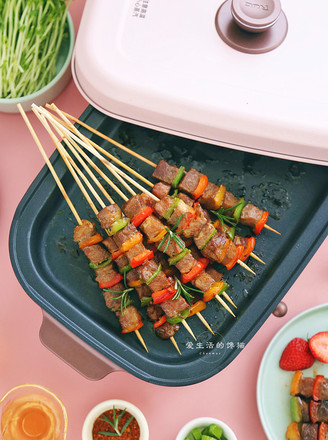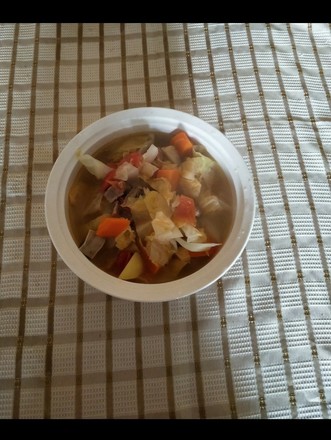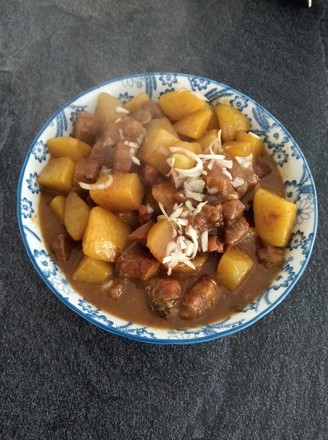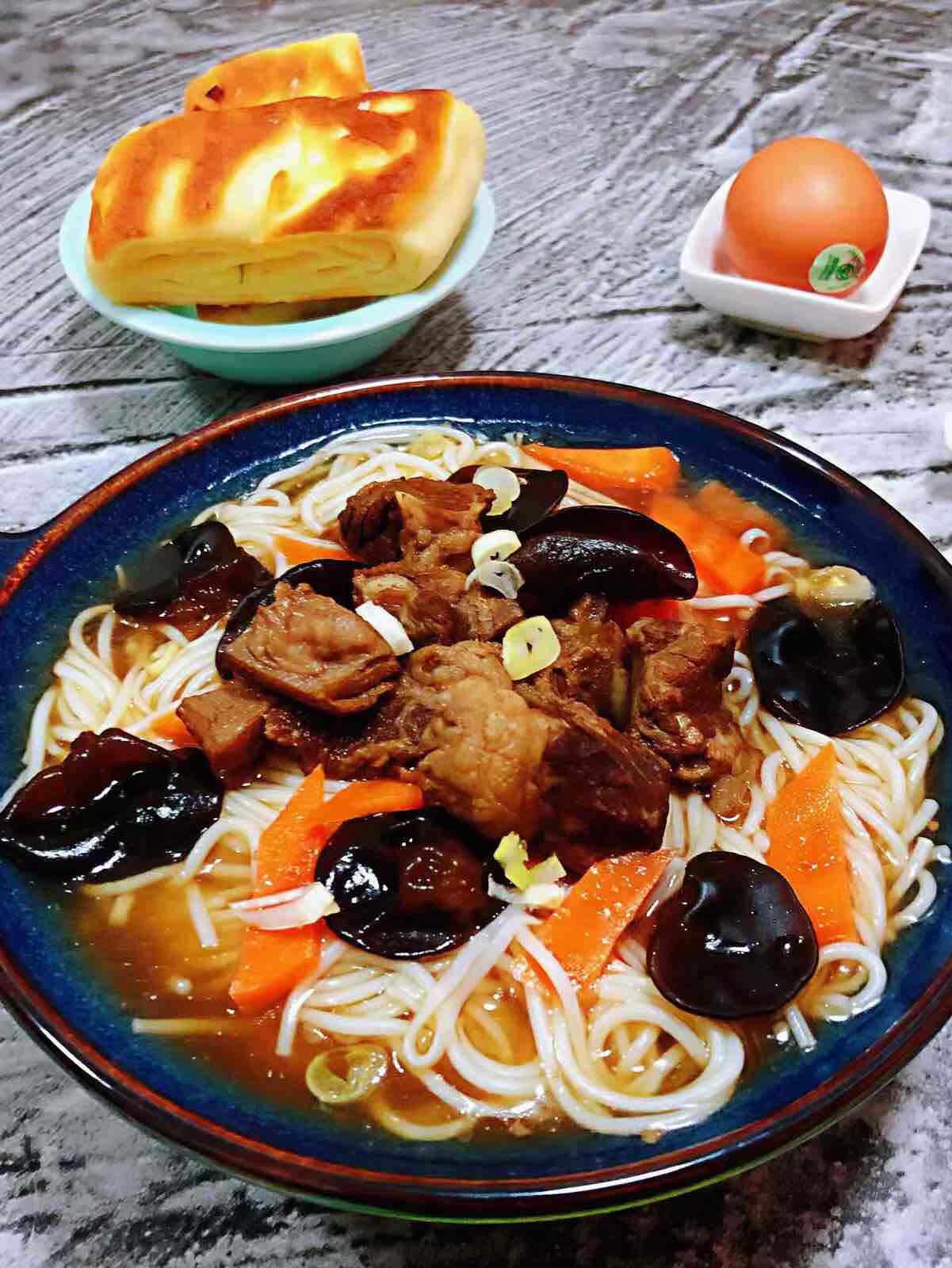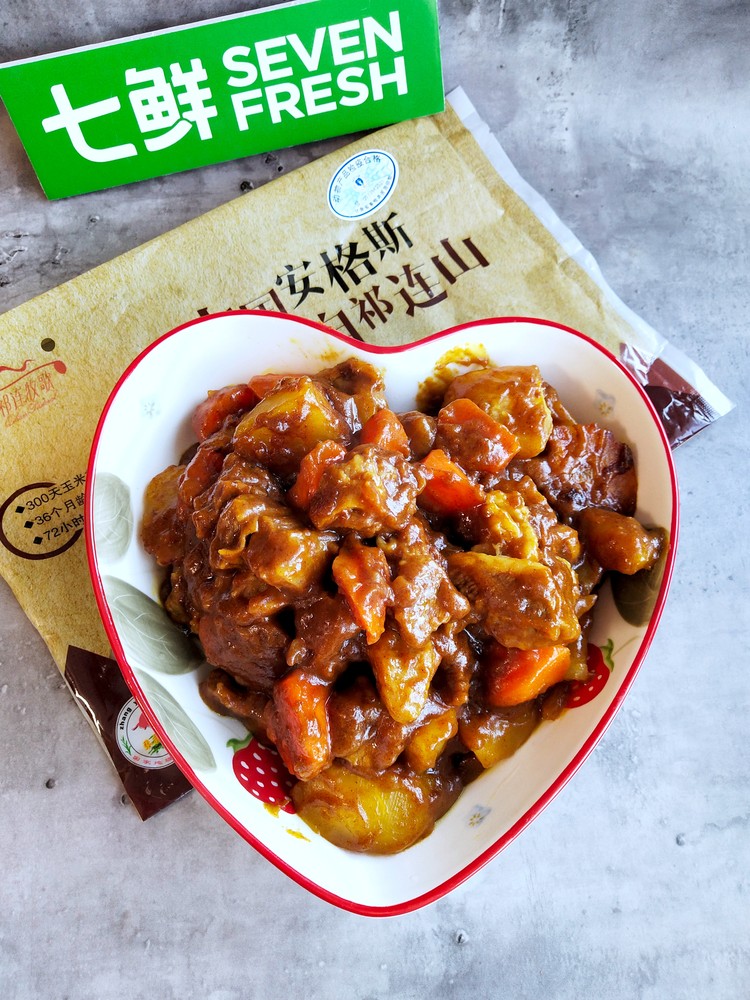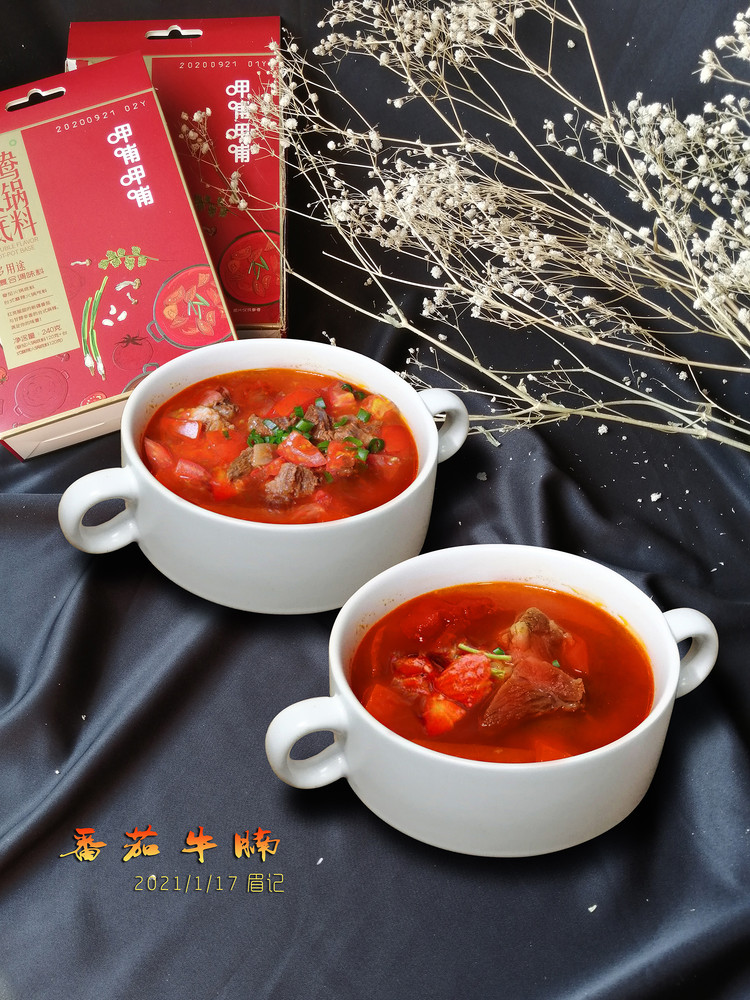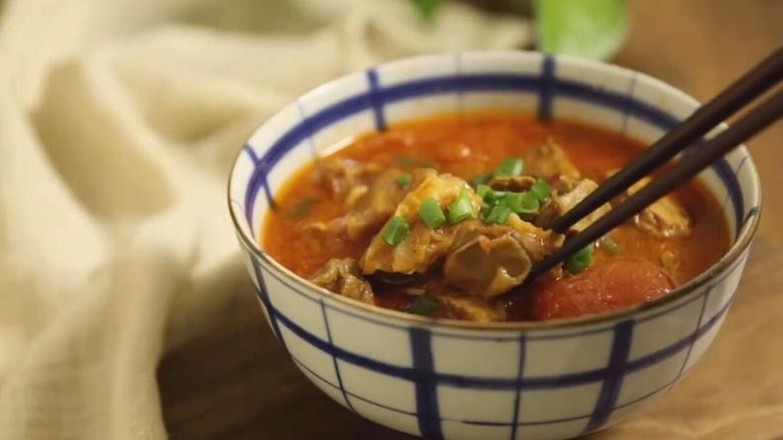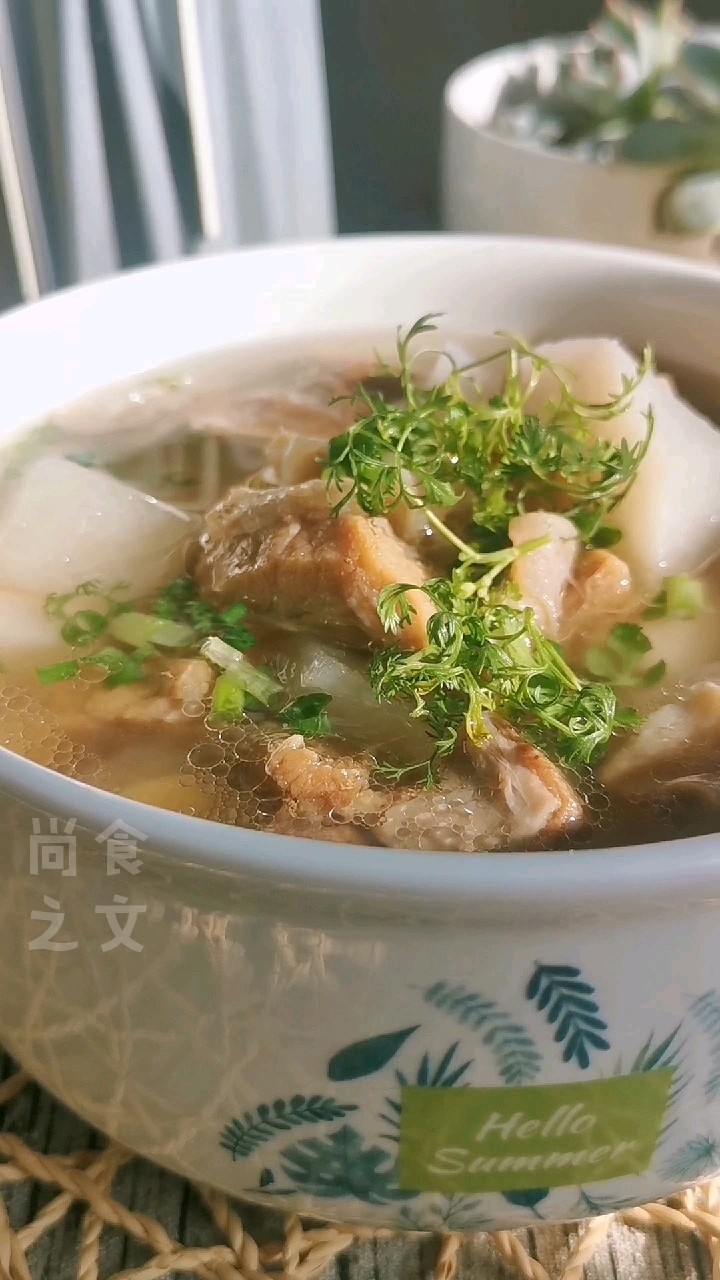[chongqing Hechuan] Braised Beef Rice Noodles
1.
Wash the sirloin and cut into two-centimeter square pieces.
2.
Boil a pot of water.
3.
Pour the sirloin into the blanching water.
4.
Blanch the water and whiten the surface.
5.
Pour it into a drain basin and rinse off the blood foam.
6.
Prepare red-oil watercress or Pixian watercress.
7.
Wash the pot, boil it dry, and add peanut oil. Because there is more beef and can be eaten several times, you can add more oil.
8.
Pour the beef and stir-fry until the surface steams dry and the beef spit oil.
9.
Add the red pepper and stir fry a few times.
10.
Add appropriate amount of red-oiled watercress or Pixian watercress. Stir fry until spit red oil.
11.
Add soy sauce and dark soy sauce and continue to stir fry until spitting oil.
12.
Add appropriate amount of water or bone broth, because it is the soup base for rice noodles, so the water is mixed more widely. The color of the soup base can be adjusted by adjusting the amount of soy sauce with reference to the picture.
13.
Put in various spices. You can put the spices in the bag, and take out the soup directly after it is boiled.
14.
Add a spoonful of sugar and Huadiao wine.
15.
Pour the beef and the soup into the pressure cooker. According to the saltiness, add a little salt as needed. The soup can be slightly lighter. You can add a little more salt when you make the rice noodles. In addition to making the soup base, the prepared beef broth can also be used for braised potatoes and white radishes in the future.
16.
After the high fire SAIC, turn to medium heat and press the pressure cooker for 25 minutes.
17.
When the pressure cooker presses the beef, you can prepare soaked rice noodles at the same time. Put clear water in the pot and put the dry rice noodles in cold water. If two people eat, just grab two handfuls. Put the rice noodles in the pot, and when they become slightly soft, scatter them with chopsticks to prevent sticking during the cooking process. After the water is boiled, turn to medium heat and cook for 5-7 minutes. When the rice noodles are soft, turn off the heat and simmer for a few minutes, until the rice noodles can be broken with a finger pinch. When cooking dry rice noodles, you can boil a few eggs.
18.
Soaked rice noodles.
19.
Remove the rice noodles, rinse with water until the water becomes clear, take them out for later use, or soak them in clear water. If you can’t finish it, put it in a fresh-keeping bag and store it in the refrigerator. You can continue eating it at the next meal. The taste of the rice noodles will not change much.
20.
Wash the pot, reduce a pot of boiling water, and blanch the rice noodles and vegetables.
21.
In the process of boiling water, wash the vegetables. Vegetables are best to use green leafy vegetables such as water spinach, rape, lettuce, spinach. My family only has red amaranth, so I can use it as I go.
22.
Chop and chop the garlic finely.
23.
Combine the condiments: salt, garlic mash, pepper noodles, chili oil, pepper oil (you can leave it alone), a little chicken essence and monosodium glutamate (you don’t have to put it)
24.
For vegetables that have been cooked for a long time, you can blanch the vegetables first and then blanch the rice noodles.
25.
After the water boils, grab the rice noodles into a colander.
26.
Put it in the pot and blanch it for about 20 seconds.
27.
Take it out and put it in a bowl. Pour beef broth, add beef cubes, and sprinkle with chopped green onions. Heyun is ready to eat.
28.
Isn't it tempting to make good rice noodles? The taste is really good.
29.
Finished product.
30.
Finished product.
31.
Finished product. Ah... I'm hungry again.

![[chongqing Hechuan] Braised Beef Rice Noodles [chongqing Hechuan] Braised Beef Rice Noodles](https://img.simplechinesefood.com/77/77c6ed8cf3263dcd5cf331eb6e4f7920.jpg)
![[chongqing Hechuan] Braised Beef Rice Noodles recipe [chongqing Hechuan] Braised Beef Rice Noodles recipe](https://img.simplechinesefood.com/bd/bdc7cd0899b9f953007836d8024e8919.JPG)
![[chongqing Hechuan] Braised Beef Rice Noodles recipe [chongqing Hechuan] Braised Beef Rice Noodles recipe](https://img.simplechinesefood.com/85/85b536c1c4279e798770a1d6acaa997f.JPG)
![[chongqing Hechuan] Braised Beef Rice Noodles recipe [chongqing Hechuan] Braised Beef Rice Noodles recipe](https://img.simplechinesefood.com/ad/ad6affd0f10a578c32fa92dd77e3b728.JPG)
![[chongqing Hechuan] Braised Beef Rice Noodles recipe [chongqing Hechuan] Braised Beef Rice Noodles recipe](https://img.simplechinesefood.com/de/de90fa4b28322df4bafe118e2ac5b3b1.JPG)
![[chongqing Hechuan] Braised Beef Rice Noodles recipe [chongqing Hechuan] Braised Beef Rice Noodles recipe](https://img.simplechinesefood.com/7c/7c3d6e6cba820e82ea8ab581087da21f.JPG)
![[chongqing Hechuan] Braised Beef Rice Noodles recipe [chongqing Hechuan] Braised Beef Rice Noodles recipe](https://img.simplechinesefood.com/1c/1c43dc0d286017ad14c0b0862b07ee91.JPG)
![[chongqing Hechuan] Braised Beef Rice Noodles recipe [chongqing Hechuan] Braised Beef Rice Noodles recipe](https://img.simplechinesefood.com/2c/2cbf391b55f888d8a210c1f301165984.JPG)
![[chongqing Hechuan] Braised Beef Rice Noodles recipe [chongqing Hechuan] Braised Beef Rice Noodles recipe](https://img.simplechinesefood.com/a1/a1a44ec1b00ffbaa15c020e1493c3f56.JPG)
![[chongqing Hechuan] Braised Beef Rice Noodles recipe [chongqing Hechuan] Braised Beef Rice Noodles recipe](https://img.simplechinesefood.com/f8/f83baead49b82bd2c52669eb704631c0.JPG)
![[chongqing Hechuan] Braised Beef Rice Noodles recipe [chongqing Hechuan] Braised Beef Rice Noodles recipe](https://img.simplechinesefood.com/c6/c6ba539694f58cbe7e2033bcee31548a.JPG)
![[chongqing Hechuan] Braised Beef Rice Noodles recipe [chongqing Hechuan] Braised Beef Rice Noodles recipe](https://img.simplechinesefood.com/f6/f6392d264e94a3c3e05a9b00df05ac49.JPG)
![[chongqing Hechuan] Braised Beef Rice Noodles recipe [chongqing Hechuan] Braised Beef Rice Noodles recipe](https://img.simplechinesefood.com/48/485456a4ececaa12da74db9004ef81b5.JPG)
![[chongqing Hechuan] Braised Beef Rice Noodles recipe [chongqing Hechuan] Braised Beef Rice Noodles recipe](https://img.simplechinesefood.com/82/82c98ddb5bdda18db3f39cab95d0aa68.JPG)
![[chongqing Hechuan] Braised Beef Rice Noodles recipe [chongqing Hechuan] Braised Beef Rice Noodles recipe](https://img.simplechinesefood.com/e3/e333723f1762dfb18ccbfa858cdd2e37.JPG)
![[chongqing Hechuan] Braised Beef Rice Noodles recipe [chongqing Hechuan] Braised Beef Rice Noodles recipe](https://img.simplechinesefood.com/1e/1ef54413a37ddebf8a2227fdb1452b49.JPG)
![[chongqing Hechuan] Braised Beef Rice Noodles recipe [chongqing Hechuan] Braised Beef Rice Noodles recipe](https://img.simplechinesefood.com/90/9048547d872425971b3f6f2643987b07.JPG)
![[chongqing Hechuan] Braised Beef Rice Noodles recipe [chongqing Hechuan] Braised Beef Rice Noodles recipe](https://img.simplechinesefood.com/9e/9ea5f399196a895c136ba563d78d32e5.JPG)
![[chongqing Hechuan] Braised Beef Rice Noodles recipe [chongqing Hechuan] Braised Beef Rice Noodles recipe](https://img.simplechinesefood.com/23/23d6d00f2a814f62d050a70a34678bbf.JPG)
![[chongqing Hechuan] Braised Beef Rice Noodles recipe [chongqing Hechuan] Braised Beef Rice Noodles recipe](https://img.simplechinesefood.com/5e/5e4bb1e360dae5be50c7cda0e0e89538.JPG)
![[chongqing Hechuan] Braised Beef Rice Noodles recipe [chongqing Hechuan] Braised Beef Rice Noodles recipe](https://img.simplechinesefood.com/92/92ffb5495df762b481eed48a9a6ef3da.JPG)
![[chongqing Hechuan] Braised Beef Rice Noodles recipe [chongqing Hechuan] Braised Beef Rice Noodles recipe](https://img.simplechinesefood.com/e5/e52197423566f892c7aa4c024b045469.JPG)
![[chongqing Hechuan] Braised Beef Rice Noodles recipe [chongqing Hechuan] Braised Beef Rice Noodles recipe](https://img.simplechinesefood.com/89/8977b7592548250aae97671a6b48c886.JPG)
![[chongqing Hechuan] Braised Beef Rice Noodles recipe [chongqing Hechuan] Braised Beef Rice Noodles recipe](https://img.simplechinesefood.com/da/dafad810d840c54a3f113b7b52cc216f.JPG)
![[chongqing Hechuan] Braised Beef Rice Noodles recipe [chongqing Hechuan] Braised Beef Rice Noodles recipe](https://img.simplechinesefood.com/69/69fdad8109d04fdf18544e74415bcf74.JPG)
![[chongqing Hechuan] Braised Beef Rice Noodles recipe [chongqing Hechuan] Braised Beef Rice Noodles recipe](https://img.simplechinesefood.com/34/34a6521261449398b6292e069e9b762d.jpg)
![[chongqing Hechuan] Braised Beef Rice Noodles recipe [chongqing Hechuan] Braised Beef Rice Noodles recipe](https://img.simplechinesefood.com/cb/cbc8a2fe4669245dcaf2950a2fde6830.JPG)
![[chongqing Hechuan] Braised Beef Rice Noodles recipe [chongqing Hechuan] Braised Beef Rice Noodles recipe](https://img.simplechinesefood.com/8f/8f5bc284d99a691bf189e6edc6d9cd51.JPG)
![[chongqing Hechuan] Braised Beef Rice Noodles recipe [chongqing Hechuan] Braised Beef Rice Noodles recipe](https://img.simplechinesefood.com/42/420b9f0853e87e4985f244228e236ab2.jpg)
![[chongqing Hechuan] Braised Beef Rice Noodles recipe [chongqing Hechuan] Braised Beef Rice Noodles recipe](https://img.simplechinesefood.com/4c/4c085d4a463c0387175e3d1ed035d158.jpg)
![[chongqing Hechuan] Braised Beef Rice Noodles recipe [chongqing Hechuan] Braised Beef Rice Noodles recipe](https://img.simplechinesefood.com/64/642894a820ff33cdf0a94540c8eca2c6.jpg)
